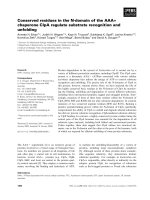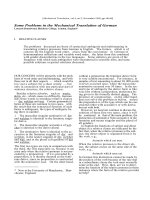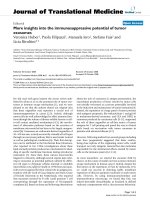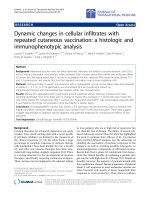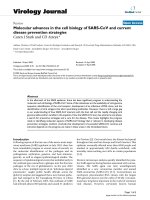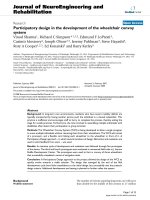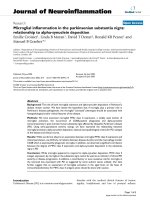báo cáo hóa học:" Mechanically-induced osteogenesis in the cortical bone of pre- to peripubertal stage and peri- to postpubertal stage mice" ppt
Bạn đang xem bản rút gọn của tài liệu. Xem và tải ngay bản đầy đủ của tài liệu tại đây (265.64 KB, 5 trang )
BioMed Central
Page 1 of 5
(page number not for citation purposes)
Journal of Orthopaedic Surgery and
Research
Open Access
Research article
Mechanically-induced osteogenesis in the cortical bone of pre- to
peripubertal stage and peri- to postpubertal stage mice
Jeffrey H Plochocki
1,2
Address:
1
Department of Anatomy, Midwestern University, Glendale, Arizona, USA and
2
Department of Biology, The Pennsylvania State
University, Altoona, Pennsylvania, USA
Email: Jeffrey H Plochocki -
Abstract
Background: Exercise during postnatal development plays a key role in determining adult bone
mass and reducing the risk of fracture and osteoporosis later in life. However, the relationship
between mechanically-induced osteogenesis and age is unclear. Elevated levels of estrogen during
puberty may inhibit periosteal bone formation. Thus, magnitudes of mechanically-induced
osteogenesis may be vary with pubertal state.
Methods: The present study uses a murine model to examine age-related changes in bone
formation at the femoral midshaft with voluntary exercise. Pre- to peripubertal mice aged 3 weeks
and peri- to postpubertal mice aged 7 weeks were randomly divided into sedentary and exercised
groups and subjected to histomorphometric comparison after 4 weeks of treatment.
Results: Results of the experiment indicate that exercise significantly increased osteogenesis on
the periosteal and endocortical surface of the mice in the older age group (P < 0.05). Exercise had
no significant effect on bone formation of mice in the younger age group, although exercised mice
exhibited more bone growth on average than controls. Endocortical apposition was the primary
method of bone formation for all mice in the experiment; however exercised mice in the older age
group were able to add more bone on the periosteal surface than age-matched controls and
exercised mice in the younger age group (P < 0.05). Medullary area increased with age, but
exercised mice in both age groups had smaller medullary cavities relative to overall bone area than
controls.
Conclusion: These findings suggest that the amount and location of mechanically-induced
osteogenesis differs by age during skeletal development. Late adolescence may be the optimal time
to accrue bone mass and maximize bone strength.
Introduction
Loss of bone mass is a serious concern for the aging pop-
ulation. Older individuals affected by osteopenia and
osteoporosis are at greater risk for age-related fractures,
which are associated with increased morbidity and mor-
tality [1]. Emerging evidence suggests that peak bone mass
is closely related to the severity of bone loss later in life
[2]. Peak bone mass is determined by both genetic and
environmental factors, including the mechanical environ-
ment of the skeleton during postnatal development [3,4].
Physical inactivity in subadults is associated with lower
bone density, and hence a greater risk of fracture, than
Published: 25 June 2009
Journal of Orthopaedic Surgery and Research 2009, 4:22 doi:10.1186/1749-799X-4-22
Received: 26 November 2008
Accepted: 25 June 2009
This article is available from: />© 2009 Plochocki; licensee BioMed Central Ltd.
This is an Open Access article distributed under the terms of the Creative Commons Attribution License ( />),
which permits unrestricted use, distribution, and reproduction in any medium, provided the original work is properly cited.
Journal of Orthopaedic Surgery and Research 2009, 4:22 />Page 2 of 5
(page number not for citation purposes)
those who are more physically active [5]. Thus, physical
activity levels during skeletal development regulate osteo-
genesis to affect bone mass and fracture risk later in life
[4].
It is clear that alterations in the magnitude of mechanical
loading of the skeleton can directly influence bone forma-
tion and maintenance during periods of skeletal growth.
However, the relationship between osteogenic response
to exercise and age is less clear. Bone formation on the
periosteal and endocortical surfaces is regulated, in part,
by hormones like estrogen [6]. Estrogens have an inhibi-
tory effect on periosteal apposition and endocortical
resorption [7,8]. Since hormone levels change throughout
development, their effect may vary with age [9,10]. The
addition of bone on the periosteal surface provides greater
resistance to bending than endocortical bone formation
because it adds bone further from the bending axis. Perio-
steal apposition would then be the optimal response to
increased mechanical loading because it maximizes bone
strength. However, elevated estrogen levels during
puberty may inhibit periosteal bone formation, thereby
promoting exercise-induced osteogenesis on the endocor-
tical surface. Therefore, there may be an age at which exer-
cise more effectively increases bone strength while adding
bone mass. Such information is important to clinicians
for understanding determinants of peak bone mass and
bone strength, and to assess fracture risk later in life.
Previous investigations into the relationship between
mechanical and hormonal regulation of diaphyseal
growth have yielded mixed results [8,10,11]. Mechanical
loading may accelerate periosteal growth before puberty
and endocortical expansion in the postpubertal stage
[8,10], but the effects of loading and estrogen may be
independent of each other [11]. The aim of this study is to
further examine the relationship between age and
mechanically-induced bone formation from voluntary
exercise in laboratory mice. Voluntary exercise treatment
is used because it allows for activity levels and durations
within a normal physiological range. Bone histomorpho-
metric comparisons are made between prepubertal to
peripubertal and peripubertal to postpubertal mice to test
the hypothesis that the location of bone formation on the
femoral diaphysis differs with age, and consequently
internal hormonal environment.
Methods
Forty-two virgin female mice of the strain C57BL/6J were
used in the experiment (Jackson Laboratory, Bar Harbor,
ME). Mice were housed in 153 in
2
cages and provided
with food and water ad libitum. After a one week acclima-
tization period, the mice were divided into four groups:
11 mice aged 3 weeks treated with exercise, 11 sedentary
control mice aged 3 weeks, 10 mice aged 7 weeks treated
with exercise, and 10 sedentary control mice aged 7 weeks.
These ages were chosen because puberty in C57BL6 mice
typically occurs by the 6
th
or 7
th
week of life and ends
shortly thereafter [12]. The 3-week-old mice in this exper-
iment are prepubertal to peripubertal, while the 7-week-
old mice are peripubertal to postpubertal. Exercise treat-
ment involved continuous voluntary access to an activity
wheel (Bio-Serv, Frenchtown, NJ). Use of the wheels was
monitored by magnetic counters and regular periods of
observation. All mice received an intraperitoneal injection
of calcein (Sigma, St. Louis, MO) at a dose of 30 mg/kg of
body mass on day 8 and 22 of the experiment. The calcein
acts as a fluorochrome label to identify areas of active
bone formation.
The experiment lasted for 4 weeks, after which the mice
were sacrificed with compressed carbon dioxide at 7 and
11 weeks of age respectively. Thus, mice in the younger
age group were treated between the ages of 3 to 7 weeks,
while mice in the older group were treated from 7 to 11
weeks of age. Note that skeletal growth is typically negli-
Table 1: Means and standard deviation of femoral parameters in control and exercise-treated mice of both age groups
7-week mice 11-week mice
Control Exercised Control Exercised
Endosteal perimeter (mm) 3.64 (0.14) 3.73 (0.16) 3.73 (0.15)
a
3.85 (0.32)
a
Periosteal perimeter (mm) 2.02 (0.18) 2.03 (0.13) 4.69 (0.14)
a
4.83 (0.27)
a, b
Cortical area (mm
2
) 0.50 (0.15) 0.52 (0.09) 0.55 (0.04)
a
0.61 (0.04)
a
Medullary area (mm
2
) 0.31 (0.05) 0.32 (0.04) 0.93 (0.07)
a
0.98 (0.14)
a
Periosteal area (mm
2
) 0.81 (0.15) 0.84 (0.08) 1.49 (0.10)
a
1.59 (0.17)
a, b
Area of endocortical bone growth (μm
2
) 26.50 (2.41) 44.66 (3.48) 35.60 (1.13) 51.20 (1.68)
b
Area of periosteal bone growth (μm
2
) 9.37 (0.28) 9.94 (0.19) 7.30 (0.68) 16.20 (0.62)
a, b, c
Total bone growth area (μm
2
) 35.87 (2.38) 54.59 (3.37) 42.90 (1.46) 67.40 (1.55)
b
Bone formation rate (μm
2
/day) 2.56 (1.69) 3.91 (2.41) 3.06 (1.04) 4.81 (1.11)
b
a
Significant difference between age groups by exercise treatment group
b
Significant difference between exercise treatment groups by age group
c
Significant age group and exercise treatment group interaction
Journal of Orthopaedic Surgery and Research 2009, 4:22 />Page 3 of 5
(page number not for citation purposes)
gible after the 16
th
week of life in this strain of mice [13].
Femora were harvested and cleaned of soft tissue and then
secured in 10% NBF, dehydrated in alcohol, and imbed-
ded in methyl methacrylate (Polysciences, Warrington,
PA) for sectioning. A low speed saw (Isomet; Buehler,
Lake Bluff, IL) was used to section the femora in the trans-
verse plane at midshaft. Sections were ground to a final
thickness of roughly 20 μm for analysis. Digital captures
of the sections were taken under fluorescent microscopy
and histomorphometric data was recorded using ImageJ
1.40 g />. Histomorpho-
metric parameters were obtained and bone formation
rates were calculated using the calcein labels. Endosteal
and periosteal perimeters were measured as the curved
length of the endosteal and periosteal surfaces. Medullary
area was calculated as the area of the medullary cavity.
Periosteal area was calculated as cortical area + medullary
area. Areas of endocortical and periosteal bone growth
were measured as the areas of new bone on the endosteal
and periosteal surfaces respectively as indicated by the
fluorochrome labeling. Total growth area was calculated
as the area of bone growth on the periosteal surface + the
area of endocortical bone growth. Bone formation rate
was calculated as the area of bone added per day at the
endosteal and periosteal surfaces. Differences between
variables were tested using analysis of variance (ANOVA).
A two-way ANOVA with age and exercise treatment as the
main effects was used to test for age-exercise treatment
interactions. Significance was set at P < 0.05.
Results
During the 4-week experiment, exercise-treated mice ran
an average of 8.3 km per day with a standard deviation of
1.08 km (7-week-old mice: 8.33 km/day, 1.10 S.D.; 11-
week-old mice: 8.27 km/day, 1.05 S.D.). There was no sig-
nificant difference in running distance between exercise-
treated mice in the two age groups (P > 0.05). However,
voluntary running exercise had a significant effect on
body mass. Exercised mice in both age groups had greater
body mass than controls at the end of the experiment (P <
0.05), although no significant difference in body mass
existed at the beginning of the experiment.
Table 1 displays summary statistics of the histomorpho-
metric parameters of the femoral midshaft and the results
of the ANOVA. The analysis indicated there are significant
differences in histomorphometric parameters between
age groups. Eleven-week-old mice in the exercise-treated
group had significantly larger endosteal and periosteal
perimeters, and cortical, medullary, and periosteal areas
than exercise-treated mice in the 7 week age group (P <
0.05). Similarly, control mice in the 11 week age group
had significantly larger endosteal and periosteal perime-
ters, and cortical, medullary, and periosteal areas than
their counterparts in the 7 week age group (P < 0.05). Age
group had no effect on the rate and area of bone growth,
except at the periosteal surface. No significant differences
were found in the area of endocortical bone growth, area
Error bar pots (mean ± 2 SE) of medullary area expressed as a percentage of periosteal area for exercised and sedentary mice aged 7 and 11 weeksFigure 2
Error bar pots (mean ± 2 SE) of medullary area
expressed as a percentage of periosteal area for
exercised and sedentary mice aged 7 and 11 weeks.
No significant differences exist between exercised and sed-
entary mice of either age group. However, mice in the older
group have substantially larger medullary areas for their given
periosteal area (P < 0.05).
Schematic representation of changes at the femoral midshaft with variable exercise treatment of mice aged 7 and 11 weeksFigure 1
Schematic representation of changes at the femoral
midshaft with variable exercise treatment of mice
aged 7 and 11 weeks. Shaded regions indicate areas of
bone growth. Cortical areas of 7-week-old mice treated with
voluntary running exercise were ~4% greater than age-
matched controls, although this difference was not significant
(P > 0.05). Cortical areas of exercise-treated mice aged 11
weeks was ~10% greater compared with controls (P < 0.05).
Mice in both age groups exhibited about 3.8 times more
endocortical growth than periosteal growth in a pattern
indicative of anterior diaphyseal drift (anterior is to the left in
this image).
Journal of Orthopaedic Surgery and Research 2009, 4:22 />Page 4 of 5
(page number not for citation purposes)
of total bone growth, and bone formation rate by age
group. Exercised 11-week-old mice, however, had a signif-
icantly greater area of periosteal bone growth than 7-
week-old exercised mice (P < 0.05).
The primary location of bone growth in all groups was on
the endosteal surface. On average, endocortical bone
growth exceeded growth on the periosteal surface by a fac-
tor of 3.8 in both exercised and sedentary control mice of
both age groups. The effect of exercise treatment varied
with age (Figure 1). No significant histomorphometric
differences were found between exercised and sedentary
control mice in the 7 week age group (Table 1). However,
exercised 11-week-old mice had significantly greater corti-
cal area, areas of endocortical and periosteal bone forma-
tion, and bone formation rate in comparison to controls
(P < 0.05). Only one variable, area of periosteal growth,
yielded a significant interaction between age group and
exercise treatment with the two-way ANOVA (P < 0.05).
Exercised mice aged 11 weeks showed significantly greater
periosteal growth in comparison to sedentary controls
than similarly treated mice in the 7 week age group.
To assess relative size differences at the femoral midshaft
with exercise and age, a comparison of the ratio of medul-
lary area to periosteal area was made (Figure 2). This sta-
tistic gives the percentage of the medullary area to the
total area of space within the periosteal perimeter.
Although no differences were found between exercise and
control mice within each age group, a significant differ-
ence was found between age groups. Mice in the 11 week
age group have substantially larger medullary areas for
their given periosteal area than mice in the 7 week age
group (P < 0.05).
Discussion
Diaphyses of load-bearing bones of the lower limb are the
most susceptible to fracture in individuals with low bone
mass [14] and thus a concern to the aging population. The
skeleton has the greatest capacity to add bone mass in
response to exercise before skeletal maturity is reached
[15,16], but the precise relationship between age and the
site of bone formation in the lower limb remains unclear.
Using a mouse model, our data indicate that endocortical
apposition was the primary method of bone formation in
both age and treatment groups. Despite this, medullary and
cortical area enlarged as age increased, suggesting endocor-
tical resorption is taking place simultaneously with endo-
cortical apposition, possibly as part of diaphyseal drift
(Figure 1). Similar results have been reported using animal
exercise models [17,18]. This pattern of bone formation
would result in a greater concentration of mass further from
the geometric centroid of the bone cross-section to main-
tain resistance to bending during growth as body mass and
femur length increase [19]. Exercised mice in the older age
group also had greater bone growth on the periosteal sur-
face than controls. Again, this growth pattern would serve
to increase the ability of the bone to resist bending forces in
exercised mice relative to controls because there is more
bone mass further from the bending axis to resist strain for
any given bending moment [20].
The magnitude of endocortical and periosteal bone
growth and rate of bone formation showed little change
with age. The average bone formation rate and area of
bone growth did not differ significantly between pre- to
peripubertal and peri- to postpubertal mice in either treat-
ment group. Given that strain rates are likely comparable
within treatment groups regardless of age, similar growth
rates may be expected [21]. However, there was a signifi-
cant age-exercise interaction with the area of periosteal
bone growth, but not endocortical growth. The dissimilar-
ity in the location of osteogenesis in response to loading
in the two age groups suggests periosteal bone formation
is regulated differently at these pubertal stages, as hypoth-
esized. Because estrogen inhibits periosteal bone apposi-
tion and endosteal resorption [22,23], mechanically-
induced osteogenesis may be limited at the periosteal sur-
face around 6 to 7 weeks of age in mice. This would
explain why mice in the older age group exhibit a greater
osteogenic response to exercise but also greater endosteal
resorption as indicated by their larger medullary cavities.
It should be noted that the findings reported here are not
entirely consistent with Garn's model based on observa-
tion of the metacarpal [24] that proposes growth occurs at
both the periosteal and endocortical surface in prepuber-
tal females, but periosteal apposition is reduced in puber-
tal females. The results of this study suggest exercise does
not simply exaggerate the growth pattern described by
Garn, but rather acts in a regulatory role in conjunction
with estrogen to differentially affect the location of osteo-
genesis. These data are more consistent with those of Bass
et al.[10] from the humeral midshaft in human tennis
players. Using MRI, they report periosteal apposition and
endocortical resorption without endocortical apposition
in peripubertal females, with increases in periosteal appo-
sition in postpubertal females. The results presented here
experimentally confirm this finding in mice, but fluoro-
chrome labels also indicate that, despite a net increase in
the size of the medullary cavity in the younger age groups,
endocortical apposition occurs as well. Shi et al. [25] also
found that late adolescent schoolchildren are better able
to increase long bone mass than younger children in
response to exercise. Our data support this finding and
further suggest that cortical mass is added on the perio-
steal surface at a faster rate than endocortical surface fol-
lowing increased mechanical loading within the normal
physiological range.
Publish with BioMed Central and every
scientist can read your work free of charge
"BioMed Central will be the most significant development for
disseminating the results of biomedical research in our lifetime."
Sir Paul Nurse, Cancer Research UK
Your research papers will be:
available free of charge to the entire biomedical community
peer reviewed and published immediately upon acceptance
cited in PubMed and archived on PubMed Central
yours — you keep the copyright
Submit your manuscript here:
/>BioMedcentral
Journal of Orthopaedic Surgery and Research 2009, 4:22 />Page 5 of 5
(page number not for citation purposes)
In light of the findings of the current study, it is clear that
the relationship between age and mechanically-induced
bone formation is complex and dynamic. Mice in the peri-
to postpubertal age group demonstrated a greater osteo-
genic response to increases in mechanical loading than
the pre- to peripubertal mice. All mice in the experiment
exhibited more growth on the endocortical surface than
the periosteal surface, but periosteal apposition is respon-
sive to mechanical loading during later growth. The
results suggest that the period of optimal bone mass
accrual may occur during peri- to postpubertal growth,
which would translate to late adolescence in humans.
Activity during this time period may be particularly
important for adding bone mass and minimizing the risk
of bone loss and fracture in adulthood. Clearly the effects
of age on the location and rate of mechanically-induced
bone formation are not simple. Currently, there are no
detailed time course change data on bone histomorpho-
metric parameters from prepubertal to postpubertal
stages. More research is needed to better understand the
complex relationship between the hormonal regulation of
bone formation and the mechanical environment.
Competing interests
The author declares that they have no competing interests.
Authors' contributions
JHP conceived and performed the study.
Acknowledgements
The author would like to thank Monique DeLisser, Tiffany Cruz, and Ade-
ola Obafemi for their assistance with histological preparations. This
research was supported by a Penn State University Research Development
Grant.
References
1. Dolinak D: Review of the significance of various low force frac-
tures in the elderly. Am J Forensic Med Pathol 2008, 29:99-105.
2. Bachrach LK: Acquisition of optimal bone mass in childhood
and adolescence. Trends Endocrinol Metab 2001, 12:22-28.
3. Heaney RP, Abrams S, Dawson-Hughes B, Looker A, Marcus R, Matk-
ovic V, Weaver C: Peak bone mass. Osteoporos Int 2000,
11:985-1009.
4. Bonjour JP, Chevalley T, Rizzoli R, Ferrari S: Gene-environment
interactions in the skeletal response to nutrition and exer-
cise during growth. Med Sport Sci 2007, 51:64-80.
5. Ischander M, Zaldivar F Jr, Eliakim A, Nussbaum E, Dunton G, Leu SY,
Cooper DM, Schneider M: Physical activity, growth, and inflam-
matory mediators in BMI-matched female adolescents. Med
Sci Sports Exerc 2007, 39:1131-1138.
6. Ogita M, Rached MT, Dworakowski E, Bilezikian JP, Kousteni S: Dif-
ferentiation and proliferation of periosteal osteoblast pro-
genitors are differentially regulated by estrogens and
intermittent PTH administration. Endocrinology. 2008,
149(11):5713-5723.
7. Kim BT, Mosekilde L, Duan Y, Zhang XZ, Tornvig L, Thomsen JS, See-
man E: The structural and hormonal basis of sex differences
in peak appendicular bone strength in rats. J Bone Miner Res
2003, 18:150-155.
8. Li C, Jee W, Chen AM, Setterberg R, Su M, Tian X, Ling YF, Yao W:
Estrogen and exercise have a synergistic effect in preventing
bone loss in the lumbar vertebrae and femoral neck of the
ovariectomized rat. Calcif Tissue Int 2003, 72:42-49.
9. Schoenau E, Neu CM, Rauch F, Manz F: The development of bone
strength at the proximal radius during childhood and adoles-
cence. J Clin Endocrinol Metab 2001, 86:613-618.
10. Bass SL, Saxon L, Daly RM, Turner CH, Robling AG, Seeman E,
Stuckey S: The effect of mechanical loading on the size and
shape of bone in pre-, peri, and postpubertal girls: a study in
tennis players. J Bone Miner Res
2002, 17:2274-2280.
11. Pajamäki I, Sievänen H, Kannus P, Jokihaara J, Vuohelainen T, Järvinen
TL: Skeletal effects of estrogen and mechanical loading are
structurally distinct. Bone 2008, 43:748-57.
12. Nelson JF, Karelus K, Felico LS, Johnson TE: Genetic influences on
the timing of puberty in mice. Biol Reprod 1990, 42:649-655.
13. Brodt MD, Ellis CB, Silva MJ: Growing C57Bl/6 mice increase
whole bone mechanical properties by increasing geometric
and material properties. J Bone Miner Res 1999, 14:2159-2166.
14. Bennell KL, Brukner PD: Epidemiology and site specificity of
stress fractures. Clin Sports Med 1997, 16:179-1796.
15. Turner CH: Site-specific skeletal effects of exercise: impor-
tance of interstitial fluid pressure. Bone 1999, 24:161-162.
16. Turner CH, Robling AG: Designing exercise regimens to
increase bone strength. Exerc Sport Sci Rev 2003, 31:45-50.
17. Jee WSS, Li XJ, Schaffler MB: Adaptation of diaphyseal structure
with aging and increased mechanical usage in the adult rat:
A histomorphometrical and biomechanical study. Anat Rec
1991, 230:332-338.
18. Mori T, Okimoto N, Sakai A, Okazaki Y, Nakura N, Notomi T, Naka-
mura TJ: Climbing exercise increases bone mass and trabecu-
lar bone turnover through transient regulation of marrow
osteogenic and osteoclastogenic potentials in mice. Bone
Miner Res. 2003, 18(11):2002-2009.
19. Turner CH, Burr DB: Basic biomechanical measurements of
bone: A tutorial. Bone 1993, 14:595-608.
20. Currey JD, Alexander RM: The thickness of the walls of tubular
bones. J Zool Lond 1985, 206:453-468.
21. Burr DB, Robling AG, Turner CH: Effects of biomechanical stress
on bones in animals. Bone
2002, 30:781-786.
22. Saxon LK, Turner CH: Estrogen receptor beta: the antimech-
anostat? Bone 2005, 36:185-192.
23. Chen JL, Yao W, Frost HM, Li CY, Setterberg RB, Jee WSS: Bipedal
stance exercise enhances antiresorption effects of estrogen
and counteracts its inhibitory effects on bone formation in
sham and ovariectomized rats. Bone 2001, 29:126-33.
24. Garn SM: The earlier gain and later loss of cortical bone. In
Nutritional Perspectives Edited by: Thomas CC. Spingfield, IL;
1970:3-120.
25. Shi H-J, Nakamura K, Kizuki M, Inose T, Seino K, Takano T: Extra-
curricular sports activity around growth spurt and improved
tibial cortical bone properties in adolescence. Acta Paediatrica
2006, 95:1608-1613.
